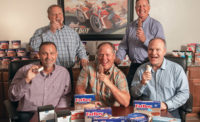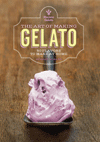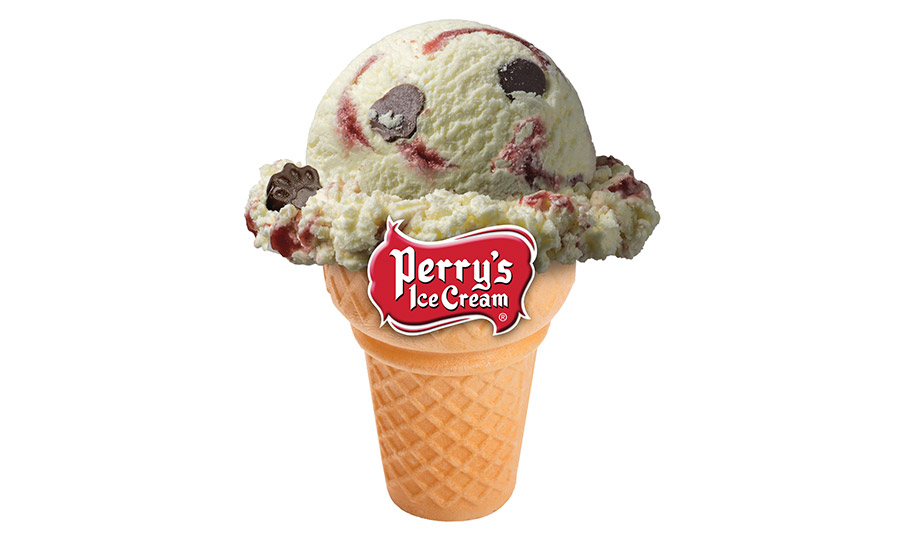Perry's Ice Cream: Celebrating 100 years of the 'good stuff'
As it celebrates its milestone anniversary, Perry’s Ice Cream is staying true to its founder’s philosophy while adapting to the changing wants and needs of customers and consumers












Back in 1918, H. Morton Perry launched the company that’s now known as Perry’s Ice Cream (Perry’s) with the purchase of a milk route in Akron, N.Y. He delivered fresh milk to customers personally, by horse and wagon. From the beginning, his mantra was: “Make sure you put in enough of the good stuff” — referring to not only the highest-quality product, but also the highest-quality service.
Not too many years later, H. Morton Perry crafted his first batch of ice cream on the kitchen stove, using his mother’s recipe. And when he began to market that ice cream, he made sure to include “enough of the good stuff” to delight new and existing customers of his dairy.
A hundred years later, the fourth generation of the Perry family, along with the rest of the management team, stays true to H. Morton Perry’s philosophy. Everyone at Perry’s still makes sure to put in enough of that good stuff.
“It refers to product that we’re making today, but it also goes all the way to include the serviceability of the product, the people, everything,” said Brian Perry, executive vice president and chair of the company.
As it celebrates its 100th anniversary this year, the fourth-generation family-owned company — still based in Akron — is holding tight to some other traditions as well. For example, Perry’s still makes ice cream one batch at a time, albeit in a much larger pot, Perry pointed out. And it continues to rely on a personal touch — direct store delivery (DSD) — in getting most of its products into customers’ hands. (Approximately 80% of product goes to retail and scoop shop customers; the remaining goes to four distributors.)
But that doesn’t mean the ice cream processor is adverse to change. In 2016, Perry’s sales topped the $100 million mark, a milestone that’s actually a testament to how well the company has been able to adapt to the changing wants and needs of its customers and consumers over the years.
Marketing products aplenty
New product development, of course, has been critical to Perry’s evolution and growth over the years. The company now boasts approximately 75 flavors under it Perry’s Premium, Perry’s Premium Lactose-Free and Perry’s Light No Sugar Added lines, as well as frozen yogurt, custard, sherbet and sorbet, frozen novelty and even dairy-free frozen dessert offerings. In addition to producing products under its own brand, Perry’s makes products for branded co-pack and private label customers.
The products are sold in multipacks/bulk (for novelties), pint containers, 48-ounce sqrounds and 3-gallon tubs for customers ranging from supermarkets and c-stores to foodservice operators, schools and independent scoop shops, the company noted. Co-branded flavors such as Let’s Dough Buffalo, which launched at the beginning 2017-2018 Buffalo Sabres season to celebrate Perry’s partnership with the National Hockey League team — keep the ice cream lineup fresh. And new limited-edition flavors such as Star Spangled Cookie and S’more Yardage also add excitement.
For 2018, in honor of its milestone anniversary, Perry’s went “back to its vault” to launch four retro flavors: Parkerhouse, Heavenly Hash, Butterscotch Sundae and Malt Shoppe, popular in the 1950s, 1970s, 1980s and 1990s, respectively. The company said it is marketing the products in retro-themed 1.5-quart packages.
“The retro line has definitely been a runaway favorite — crazy successful,” said Gayle Perry Denning, vice president of sustainability and strategic branding.
How successful? According to Robert Denning, president and CEO, Perry’s reached 150% of its sales target in the first half of the year.
“I predict we’ll be in the 200% range with these flavors by the end of the year,” he said.
Denning also said the response to the retro flavors on social media has been “outstanding.”
“Our followers have been raving, just raving about our products,” he said.
Two of the retro flavors — Parkerhouse, a combination of amaretto ice cream and maraschino cherries, and Heavenly Hash, a mix of chocolate and marshmallow swirled ice cream, Swiss chips and roasted almonds — have been so popular that they will be sticking around after the anniversary celebration is over, Perry Denning said.
“Maybe, by popular demand, the others will make reappearances one day,” she added.
Another anniversary flavor, meanwhile, is exclusive to Perry’s scoop shop customers. Called The Good Stuff, the flavor combines yellow cake ice cream with strawberry swirls and panda paw cups filled with strawberry cream, the company noted. The flavor was inspired by founder H. Morton’s favorite topping (strawberry) and Perry’s signature Panda Paws.
Speaking of the scoop shop channel, consisting of roughly 1,000 independently owned locations, that’s where Perry’s really plays and wins, Denning noted. In fact, the channel has grown 30% in just the last five years.
And Perry’s likes to maintain a little exclusivity within that channel when it comes to flavors.
“It’s a point of differentiation for the scoop shop purveyors,” Denning noted. “It’s great marketing, too. Customers can see the breadth of our flavors.”
Tracking trends
New flavors don’t just happen, of course. Perry’s boasts a top-notch product development team that begins with the discovery process, which takes place generally about a year and a half before a new flavor, or an entirely new product, launches, Perry Denning said. During the discovery process, the team considers trends across the bakery, beverage, candy and other segments, she added.
Perry’s new product development team looks at internal trends data, too, Denning noted. And some suppliers also are excellent sources for inspiration.
“We partner with fewer, larger-scale strategic suppliers, and they bring us concepts that are on trend,” he said. “Some are unique, further out.”
Those suppliers have developed great relationships with Perry’s over the years, so they are loyal and willing to share potential new concepts with the company, Perry added.
“They know our reputation and how we work with them,” he said.
One recent ice cream flavor launch that combines current trends and supplier capabilities is Cold Brew Coffee & Cream (and it’s Denning’s favorite flavor).
“While cold brews have been popular in the retail coffee channel, we were the first or one of the first to commercialize cold brew in packaged ice cream,” Denning said. “It’s been well received.”
Another recent product launch, a dairy-free, plant-based frozen dessert line, was inspired by the growing consumer base following a flexitarian diet.
“Maybe today they are having dairy; maybe not tomorrow,” Denning explained. “Maybe the next day, they are eating organically.”
Millennials are a big part of that flexitarian demographic — and are definitely on Perry’s radar when it comes to new product development.
“They have purchasing power,” Denning noted. “They’re raising families, young, growing families. And they are purchasing differently than we did. They’re seeking more proactive nutrition, whether it’s higher protein or lower sugar.”
Expanding markets
Great products and inspired flavors have been critical to Perry’s growth over the past 100 years, but they certainly have not been the only growth drivers. The company’s commitment to new markets outside of western New York has been critical, too — especially in recent years.
Since it entered the international market in 2007, the company said it has grown its sales territory to more than 30 countries. And since 2015, Perry’s has doubled the square mileage of its U.S. DSD routes.
“We had about 50,000 square miles of a territory,” Denning said. “Now, we are well over 100,000 square miles and actually approaching 60 routes. We added six or seven routes this summer, mostly in Pittsburgh and Ohio.”
Perry’s products now can be found across all of New York and all of Ohio, as well as in western Pennsylvania and parts of Indiana, Kentucky and West Virginia. (Selected products can even be found on Amazon.com!)
The new Ohio and western Pennsylvania territory potentially adds about 10 million consumers to the millions of consumers the Perry’s brand already reached. And despite some strong competition in those markets, Perry’s products have been well received, Denning said.
“We’re not afraid of good competition; it only makes us better,” he added. “We make a great product and we have great people. One of our hallmarks is great service.”
Billboards and radio ads are in are in the works to help market the Perry’s brand in Ohio, he said. The brand will be participating in some events in the state, too. And the company’s trucks are another strong marketing tool.
“Our fleet of vehicles has our brand, our messaging and our products on it,” Denning explained.
Investing in people
Tasked with providing much of that great service are Perry’s DSD drivers. They share in the company’s values and go above and beyond what’s expected in terms of customer relations.
“They listen to our customers, and they respond to our customers — whether they come back here and get product and take it back to them or make a favorable impression with a handshake, a smile, a compassionate ear,” Denning said. “Our drivers are a key differentiating point for us.”
And the company’s customers take notice. Perry said he and Denning typically hear nothing but good things about the drivers when they embark on random customer visits.
“The No. 1 unaided response is ‘The drivers are great,’” he noted.
The drivers — and the top-quality service they provide — are so important to Perry’s that the company is willing to make significant investments to support them. For example, drivers have been hard to find at times, so the company opted to hire “good people” instead, Perry said.
“Then we worked with different driver training schools in different areas and put them through the training,” he said. “That’s been pretty successful in the outlying areas.”
Driver training in other areas is also hands-on, Perry Denning explained.
“It’s easier when you can adapt them to your culture, kind of build them from the ground up,” she added.
And Perry’s is getting ready to outfit its drivers with brand-new technology — handheld devices that will give them improved order visibility and flexibility at the point of delivery, Denning said.
“They will have a lot of history and data; the next-generation handheld is also going to replace a good portion of our back-room business systems,” he noted. “Another nice thing about the technology is that it’s the way that younger people want to work. They don’t want a clipboard.”
Outside of its driver workforce, Perry’s also boasts a talented team of employees who work in its plant and connected corporate offices. The loyalty of many of those employees is impressive.
“Brian and I were just signing some recognition letters, and I was amazed to read 30 years, 35 years, 40 years, 45 years,” Denning said. “We see younger team members come; they get married, have a family, buy a house. It’s exciting, growing up with the generations and experiencing their lives and families.”
Not every employee comes to Perry’s at the start of his or her career, of course. The company does like to hire some people with outside experience and specific talents, too, Perry said.
“It’s a nice mix of promoting from within and hiring great talent from outside,” he noted.
And like many other employers today, Perry’s does find it challenging at times to hire and retain entry-level employees — particularly at its distribution center. But the company is addressing those issues.
“We’ve been very purposeful in increasing our wage and our benefits and our flexibility where we can,” Denning explained.
Another positive aiding in employee retention is the company’s commitment to staying current with its facilities, amenities and technology, Perry Denning said. For example, the employee cafeteria has charging stations, Wi-Fi and other features young people value. And after Perry’s completes the upgrade to Microsoft Office 365, it plans to use Yammer, a modern social networking service, for some key team member communications.
“There’s a lot of new and different things that we do culturally to stay fresh and current because there are different expectations today,” she said. “Workplace flexibility — that’s becoming more and more common here. Work is what you do, not where you are.”
Looking ahead
In 2006, Denning penned a vision for Perry’s, stating that the company wanted to be a “viable growing company and competitor on this national and global stage.” Among the keys to getting there, he said, would be upgrading its manufacturing and distribution services to “world-class standards.”
Since then, Perry’s has injected more than $25 million in capital investments in its facility, Denning said, and can now call itself not only a regional standout, but also an international player.
Denning’s strategy to expand geographically in 2016 resulted in Perry’s posting revenues exceeding $100 million in sales for the first time ever. As it enters the first of its next 100 years in 2019, Perry’s can be expected to continue to invest in its future.
“Our business strategy drives us to invest in and support our customers’ needs of today and tomorrow and to grow and change,” Perry said.
And the company will continue to innovate within the product arena to keep up with evolving consumer wants and needs. Pint-sized offerings and plant-forward products all present significant growth opportunities, Denning said.
As for the next five years, Denning said he sees the company continuing to invest and grow, with top-line sales approaching $150 million with a balanced combination of Perry’s three revenue drivers: the Perry’s Ice Cream brand, a contract manufacturing channel and partner brand distribution.
And for the near-term future, the fourth-generation Perry’s and leadership team will continue to identify strategic growth opportunities. The “fifth generation,” meanwhile, is pursuing interests in high school, college and early careers outside of Perry’s.
Rest assured, as it moves forward, Perry’s will continue to adhere to the values set forth by the company’s founder. That means customers and consumers can expect more of the “good stuff” for many years to come.
Looking for a reprint of this article?
From high-res PDFs to custom plaques, order your copy today!















